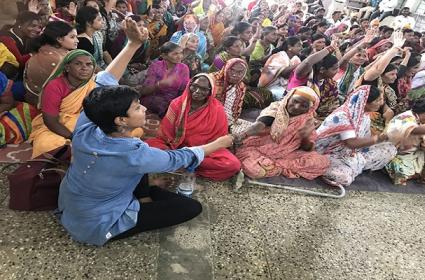Community Housing, The Future of Slum Dwellers in India

As per 2011 census, about 17% of the urban Indian population lived in informal settlements, also known as slums or basti. Slums are occupied by people who do not have the economic means to possess better homes. To understand the physical condition of these places, it is pertinent to take into account the human condition, which enables survival with extremely limited resources.
Pooja, a 25-year-old mother with two children under the age of five lives in a slum with her husband and in-laws. As most of her family members work, Pooja stays at home to care for her children and perform household chores, such as waiting in queues for water, etc. She lives in a house that is surrounded by a courtyard where she and her neighbors share space. In these facilities, people can wash clothes, clean utensils, and prepare meals. When these areas are not being utilized for household chores, they become play areas for children and social gathering places for the elderly. When Pooja needs to visit the doctor, she leaves her children in the courtyard area under the watchful eyes of her aunt next door.
Pooja’s story is not unique, and her living arrangement is similar to many in the slum. Trust and co-dependency are developed over time as people make their homes in an alien city with insufficient resources and share both positive and negative experiences. Consequently, slum communities develop a strong social fabric, making them resilient to survive under tough conditions.
People's value does not solely depend on their financial positions, but also on their social capital. In the way slum redevelopment is approached currently, residents are regarded as beneficiaries who should be instructed on how to live their lives appropriately. As a result, impersonal multi-story buildings are constructed with no resident having the agency to decide where and how to live. The current redevelopment undertaking destroys the social fabric of slum communities by excluding them from participating in the decision-making process. Additionally, the top-down approach does not foster a sense of ownership that is necessary for sustainable development. With slum redevelopment, communities get the chance to make their neighborhoods healthier and more robust. When designing and building for communities on the margins it is important to ask if we, ourselves would live in the spaces we build for them.
Design can become inclusive and democratic by treating slum communities as equal stakeholders and not as mere beneficiaries. Take the scenario of a slum with families who are reluctant to accept multi-storey living and want all their new homes to be built on the ground floor. Simple design tools can be used to help slum residents understand the need for multi-storey buildings. One such instance involved the design team providing model blocks and a map to residents, asking them to fit all the houses without stacking them. In the end, when the residents could not fit all their homes after two hours, they themselves understood why it was necessary to build two-story buildings, which gave them the confidence to proceed with the proposed plan and organise themselves accordingly.
It is important to incorporate sustainability and climate resiliency in the design of the buildings itself. By enabling passive cooling mechanisms such as natural lighting and ventilation, one can reduce the amount of electricity consumed. The use of local construction resources and materials reduces the carbon footprint of construction projects. Additional factors that contribute to sustainability include rainwater harvesting and solar lighting. For slum redevelopment to be both environmentally friendly and to have healthy and easily maintained spaces, an integrated approach to architecture, landscape and sustainability are important.
Moreover, it is equally imperative to address the financial framework for redeveloping slums in addition to tapping into the inherent social cohesion. For future projects, social impact investments can play an important role in scaling up this process across thousands of slum communities in India by combining community contributions, government subsidies, philanthropic capital and corporate social responsibility.
People living in slums are the backbone of most cities and a healthy society can only be achieved if all its citizens are thriving. As the urban population continues to increase, it is imperative to change the perception of slums from blight to one of great potential for humanity. Therefore, we must use the vibrant social capital and social infrastructure within slums to support residents in reimagining their physical spaces as safe and healthy places to live, work and play.
The article is authored by Sandhya Naidu Janardhan, Founder & MD, Community Design Agency



















